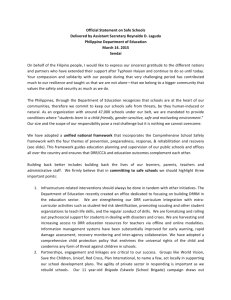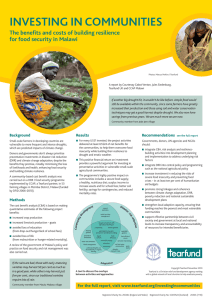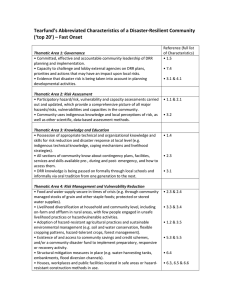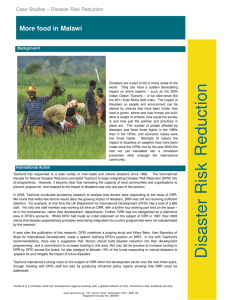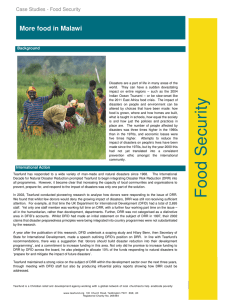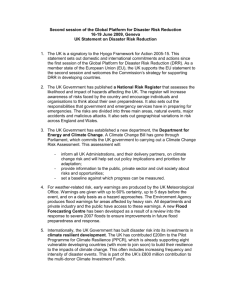Disaster Risk Reduction – More food in Malawi
advertisement
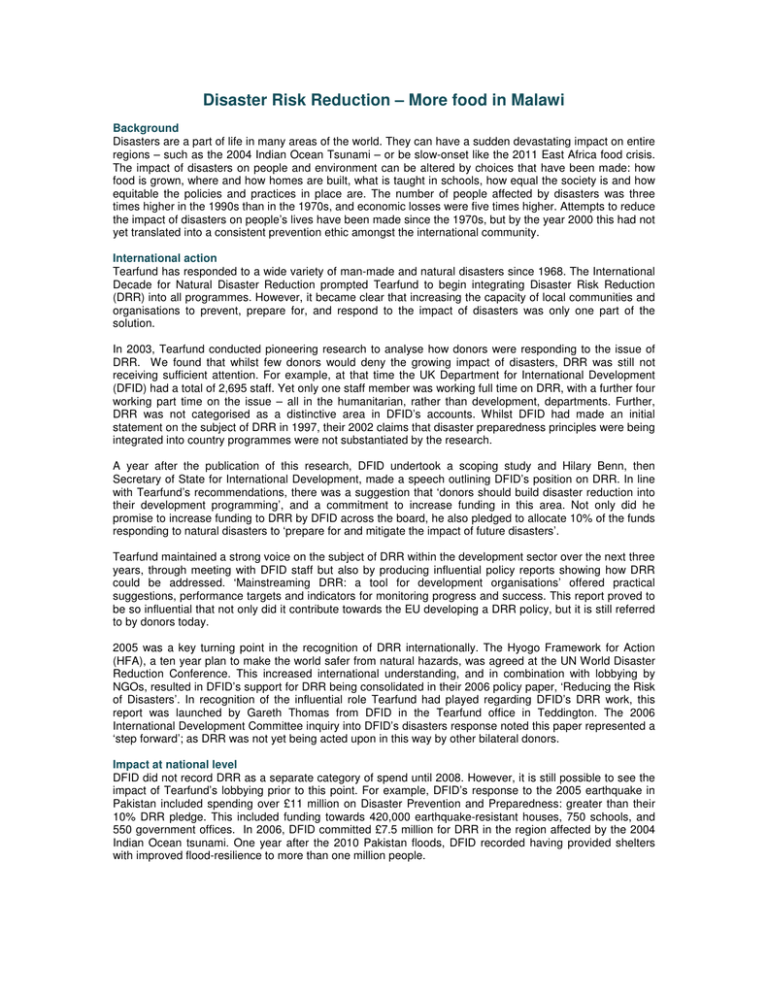
Disaster Risk Reduction – More food in Malawi Background Disasters are a part of life in many areas of the world. They can have a sudden devastating impact on entire regions – such as the 2004 Indian Ocean Tsunami – or be slow-onset like the 2011 East Africa food crisis. The impact of disasters on people and environment can be altered by choices that have been made: how food is grown, where and how homes are built, what is taught in schools, how equal the society is and how equitable the policies and practices in place are. The number of people affected by disasters was three times higher in the 1990s than in the 1970s, and economic losses were five times higher. Attempts to reduce the impact of disasters on people’s lives have been made since the 1970s, but by the year 2000 this had not yet translated into a consistent prevention ethic amongst the international community. International action Tearfund has responded to a wide variety of man-made and natural disasters since 1968. The International Decade for Natural Disaster Reduction prompted Tearfund to begin integrating Disaster Risk Reduction (DRR) into all programmes. However, it became clear that increasing the capacity of local communities and organisations to prevent, prepare for, and respond to the impact of disasters was only one part of the solution. In 2003, Tearfund conducted pioneering research to analyse how donors were responding to the issue of DRR. We found that whilst few donors would deny the growing impact of disasters, DRR was still not receiving sufficient attention. For example, at that time the UK Department for International Development (DFID) had a total of 2,695 staff. Yet only one staff member was working full time on DRR, with a further four working part time on the issue – all in the humanitarian, rather than development, departments. Further, DRR was not categorised as a distinctive area in DFID’s accounts. Whilst DFID had made an initial statement on the subject of DRR in 1997, their 2002 claims that disaster preparedness principles were being integrated into country programmes were not substantiated by the research. A year after the publication of this research, DFID undertook a scoping study and Hilary Benn, then Secretary of State for International Development, made a speech outlining DFID’s position on DRR. In line with Tearfund’s recommendations, there was a suggestion that ‘donors should build disaster reduction into their development programming’, and a commitment to increase funding in this area. Not only did he promise to increase funding to DRR by DFID across the board, he also pledged to allocate 10% of the funds responding to natural disasters to ‘prepare for and mitigate the impact of future disasters’. Tearfund maintained a strong voice on the subject of DRR within the development sector over the next three years, through meeting with DFID staff but also by producing influential policy reports showing how DRR could be addressed. ‘Mainstreaming DRR: a tool for development organisations’ offered practical suggestions, performance targets and indicators for monitoring progress and success. This report proved to be so influential that not only did it contribute towards the EU developing a DRR policy, but it is still referred to by donors today. 2005 was a key turning point in the recognition of DRR internationally. The Hyogo Framework for Action (HFA), a ten year plan to make the world safer from natural hazards, was agreed at the UN World Disaster Reduction Conference. This increased international understanding, and in combination with lobbying by NGOs, resulted in DFID’s support for DRR being consolidated in their 2006 policy paper, ‘Reducing the Risk of Disasters’. In recognition of the influential role Tearfund had played regarding DFID’s DRR work, this report was launched by Gareth Thomas from DFID in the Tearfund office in Teddington. The 2006 International Development Committee inquiry into DFID’s disasters response noted this paper represented a ‘step forward’; as DRR was not yet being acted upon in this way by other bilateral donors. Impact at national level DFID did not record DRR as a separate category of spend until 2008. However, it is still possible to see the impact of Tearfund’s lobbying prior to this point. For example, DFID’s response to the 2005 earthquake in Pakistan included spending over £11 million on Disaster Prevention and Preparedness: greater than their 10% DRR pledge. This included funding towards 420,000 earthquake-resistant houses, 750 schools, and 550 government offices. In 2006, DFID committed £7.5 million for DRR in the region affected by the 2004 Indian Ocean tsunami. One year after the 2010 Pakistan floods, DFID recorded having provided shelters with improved flood-resilience to more than one million people. National case study: Malawi One of the countries to have benefitted from DFID’s increased action on DRR is Malawi. Malawi is vulnerable to extreme weather events, notably drought and flooding. In 2002, a severe drought resulted in thousands of deaths and impacted over 2.83 million people. DFID funded a consortium of six Tearfund partners in Malawi to undertake DRR and food security activities. River of Life, Rolec, CCAP, EAM, Eagles and AGREDS worked with Tearfund staff to lobby the government of Malawi. They called on them to implement their DRR policies at the District level, in addition to carrying out their own DRR activities ranging from education in schools, to working with communities to build grain banks. The government of Malawi has responded to the work of the consortium by incorporating them into a national task force to facilitate the development of disaster risk management policy. This policy is nearly complete and at the time of writing (early 2012) is due to be presented to the Malawian Parliament. Community Impact In Mzimba District, subsistence farming is the way of life for many people. However, erratic weather conditions were resulting in families, on average, having insufficient food for four months each year. After the 2002 drought, communities reported the use of extreme coping strategies such as prostitution, or eating roots. Some were shot and killed by game wardens as they tried to hunt animals in the neighbouring game park. DFID’s consortium programme has helped 141,700 families in 53 remote villages of this district to become more food secure. Crop yields have doubled in normal rainfall years, and have also improved in regular rainfall years due to better irrigation and water management techniques. Tearfund research into the Malawian programme discovered that for every US$1 invested in the communities, US$24 of benefits were delivered; a statistic cited in the recent independent ‘Humanitarian Emergency Response Review’. Andrew Mitchell referred to this research at the launch of the report, suggesting that Tearfund’s influence on DRR remains high. The risks of devastation and starvation for communities in Malawi have now been greatly diminished as Mama Nyamwale comments: Villagers planted vertiver grass using a water conserving fallow/ridge system ‘As a result of the DRR intervention, my family has changed as I have been able to buy fertiliser this season…which has helped me a lot. Alongside that I have been able to help my children to go school as I have no husband to help. The project has brought in some change in the area not only to my family but many in our areas been helped. At first I only harvested two 50kg bag but now am able to harvest eight 50kg bags which is a miracle to me and my kids. We are really fighting hunger!’
